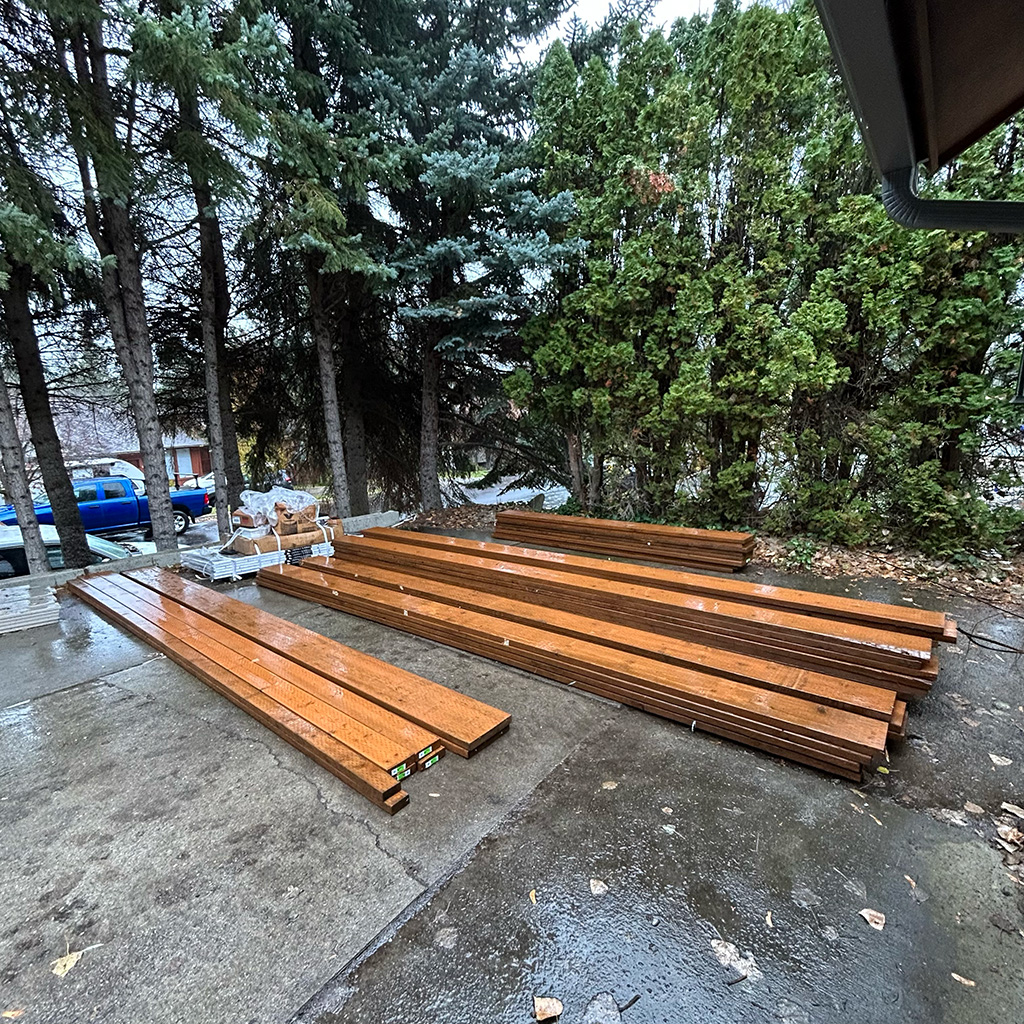
Benefits of Pressure-Treated Lumber for Decks
Are you planning to build a deck in Spokane, Washington or nearby areas like Coeur D’Alene, Idaho? If so, one of the biggest questions you’ll face is what type of lumber to use. With the region’s wet climate, it’s crucial to choose a material that can withstand heavy rainfall, moisture, and fluctuating temperatures.
At Pacific Northwest Decks, we’ve built countless decks in Spokane and know that pressure-treated wood is often the best choice. In this article, we’ll cover what pressure-treated wood is, its benefits, and alternatives, so you can make an informed decision for your deck project.
What Is Pressure-Treated Wood and Why Is It Best for Wet Climates?
Pressure-treated wood is lumber that has been infused with chemical preservatives to resist rot, decay, and insect damage. These preservatives make it more durable than untreated wood, making it ideal for outdoor projects in Spokane’s damp climate.
The treatment process involves placing the wood into a vacuum chamber and forcing preservatives deep into the fibers. This process uses pressure to ensure the chemicals penetrate the wood, protecting it from fungi, termites, and other pests. In wet climates like Spokane, this protection is especially crucial because it helps prevent moisture-related issues such as mold and mildew growth. If you’re considering a ground-level deck, learn more in our blog post, Can I Build A Deck Directly On The Ground?.
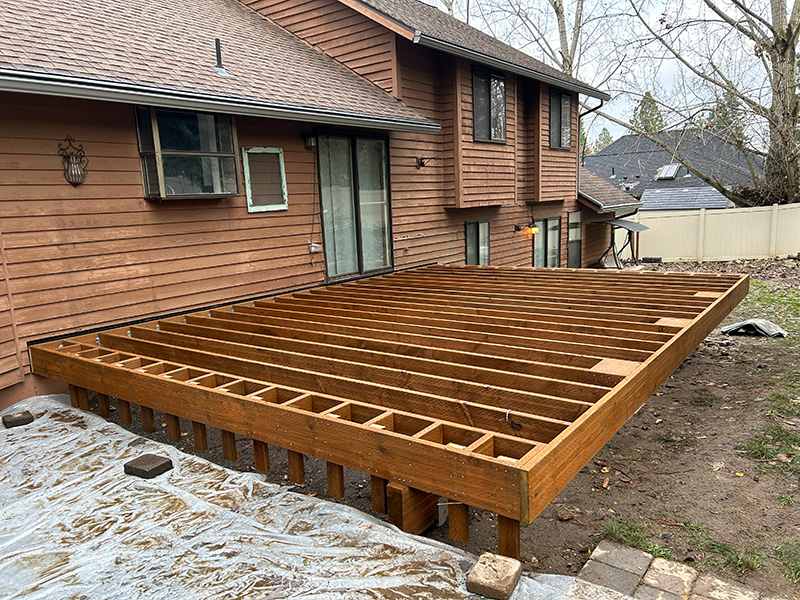
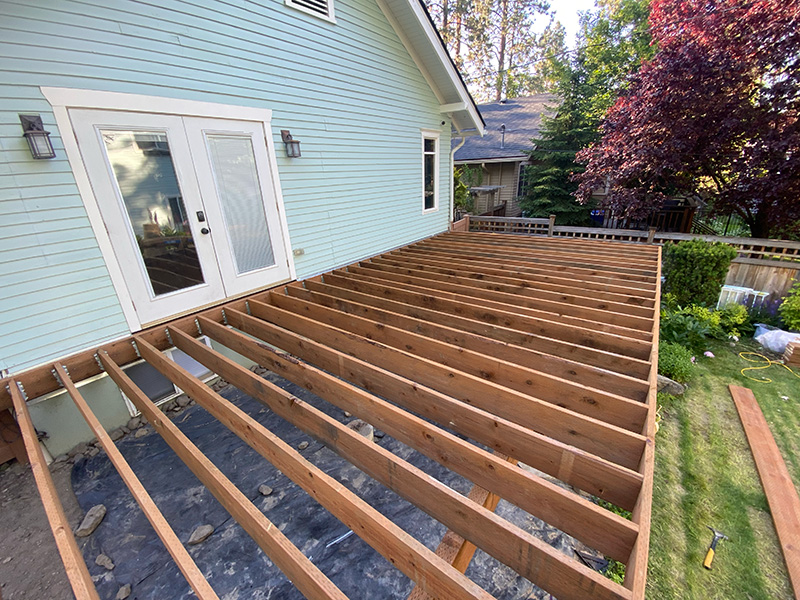
The Benefits of Using Pressure-Treated Lumber for Your Spokane Deck
Using pressure-treated wood offers several advantages for decks built in and around Spokane.
How Does Pressure-Treated Wood Add Longevity to Decks?
Pressure-treated wood is specifically designed to withstand the wet climate of the Pacific Northwest. With regular exposure to moisture, untreated wood can warp, rot, or suffer from fungal decay within a few years. Pressure-treated wood, on the other hand, is resistant to these issues.
Imagine building a ground-level deck where moisture from the soil is a constant challenge. Pressure-treated wood provides a solid, rot-resistant foundation that can last between 30 to 50 years with proper maintenance. This durability is due to its ability to repel moisture and resist insects, giving you peace of mind that your deck will remain structurally sound, even in Spokane’s rainy conditions. Additionally, if properly installed and maintained, pressure-treated wood can hold its shape and strength over time, reducing the need for repairs.
Why is Pressure-Treated Wood Worth the Investment for Decks?
Pressure-treated wood is both affordable and long-lasting, making it a popular choice for budget-conscious homeowners in Spokane and Coeur D’Alene. The initial cost typically ranges from $6 to $8 per square foot, which is more than untreated Douglas fir but less than high-end alternatives like steel framing.
While Douglas fir has a lower upfront cost, it requires frequent maintenance to prevent rot and decay. Pressure-treated wood, however, offers significant cost savings over time due to its lower maintenance needs. The chemicals used in pressure-treated wood help keep it resistant to pests and moisture, which means less frequent resealing, staining, or board replacements. This makes pressure-treated wood a practical, long-term investment for Spokane homeowners who want a durable deck that doesn’t require extensive upkeep. If you’re interested in a more detailed cost breakdown, check out our blog post, How Much Does It Cost To Build A Deck? Everything You Need to Know.
Is Pressure-Treated Wood the Most Versatile Choice for Decks?
Whether you’re planning an elevated deck with scenic views, a multi-level deck, or a simple, ground-level patio, pressure-treated wood is versatile enough to handle various designs. It is strong enough for load-bearing structures like deck beams, joists, and posts, making it adaptable for different layouts and styles.
Pressure-treated wood can be cut and shaped easily, making it suitable for decks with intricate designs or custom features like built-in seating, privacy screens, and pergolas. If you’re considering a custom deck design, check out our Custom Deck Services for inspiration and ideas tailored to your specific needs.
How Easy Is It to Maintain Pressure-Treated Wood Decks?
If you’re like most homeowners, you want a deck that requires minimal upkeep. Compared to untreated wood, pressure-treated lumber is easier to maintain. While it’s still recommended to clean your deck annually to remove dirt, moss, and debris, pressure-treated wood doesn’t require frequent sealing or staining like Douglas fir does.
However, it’s still wise to apply a water-repellent finish to help maintain the wood’s appearance and prolong its life, especially when exposed to constant moisture in Spokane. This reduced maintenance means less hassle for you and more time spent enjoying your outdoor space.
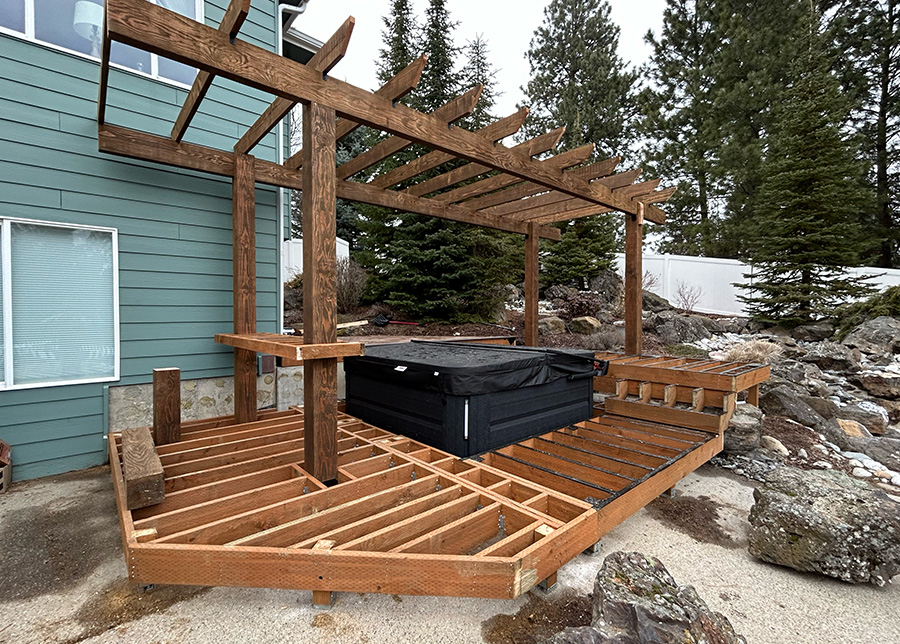
Drawbacks of Using Pressure-Treated Wood for Your Deck
While pressure-treated wood has many advantages, it’s important to consider some of the potential drawbacks.
Does Pressure-Treated Wood Affect Your Deck’s Appearance?
One downside to pressure-treated lumber is its appearance. During the treatment process, preservatives are injected into the wood, leaving visible injection points that can affect the wood’s natural grain. Unlike Douglas fir, which showcases a clear, natural wood grain, pressure-treated wood’s aesthetic is more utilitarian.
If you want a clear, natural look, you may need to add fascia boards or consider other materials for visible parts of the deck. Staining or painting the pressure-treated wood can help improve its appearance, though it still may not match the refined look of untreated wood.
Are There Environmental Concerns with Pressure-Treated Wood?
The treatment process involves chemical preservatives, which can raise environmental concerns for some homeowners. While modern pressure-treated wood uses safer, copper-based preservatives, there is still a chance for chemicals to leach into the soil.
If you’re concerned about the environmental impact, look for suppliers in Spokane that adhere to strict environmental standards for chemical treatments. Additionally, use proper safety measures during installation—such as wearing gloves and using protective eyewear—to minimize direct contact with the wood’s surface.
What Are the Best Alternatives to Pressure-Treated Wood?
If pressure-treated wood doesn’t align with your preferences, there are alternative materials that may better suit your deck project.
Should You Consider Douglas Fir for Your Deck?
Douglas fir is a more affordable option, typically costing $4 to $5.50 per square foot. It offers a natural wood grain and can be stained for a more appealing look. However, it requires regular maintenance to prevent moisture damage, making it less ideal for wet climates without consistent upkeep.
Douglas fir’s natural aesthetic is appealing to those who prefer a more traditional wood look. However, it requires staining or sealing every 3-5 years to maintain its resistance to moisture and prevent warping or splitting.
Is Treated LVL Worth the Cost for Longer Spans?
Treated laminated veneer lumber (LVL) is known for its strength and flat surface, making it a good option for longer spans and perfectly level decks. It’s moisture-resistant and treated to resist insects and decay, but it costs around $45 per square foot, making it one of the more expensive options.
Treated LVL is best suited for high-end deck projects where a perfectly flat surface is a priority. It also works well for elevated decks that require additional structural support.
Is Steel Framing a Durable Option for Decks?
Steel framing offers exceptional durability, fire resistance, and the ability to span longer distances. It won’t warp, rot, or decay, making it a solid choice for decks. However, it’s among the most expensive options, comparable to treated LVL. Proper installation is crucial to prevent rust, and the cost may be prohibitive for some homeowners.
Steel framing is ideal for decks that require significant structural support, such as multi-level decks or those with heavy features like hot tubs. It provides a flat, stable surface that remains unaffected by weather, making it a long-term, but costly, investment.
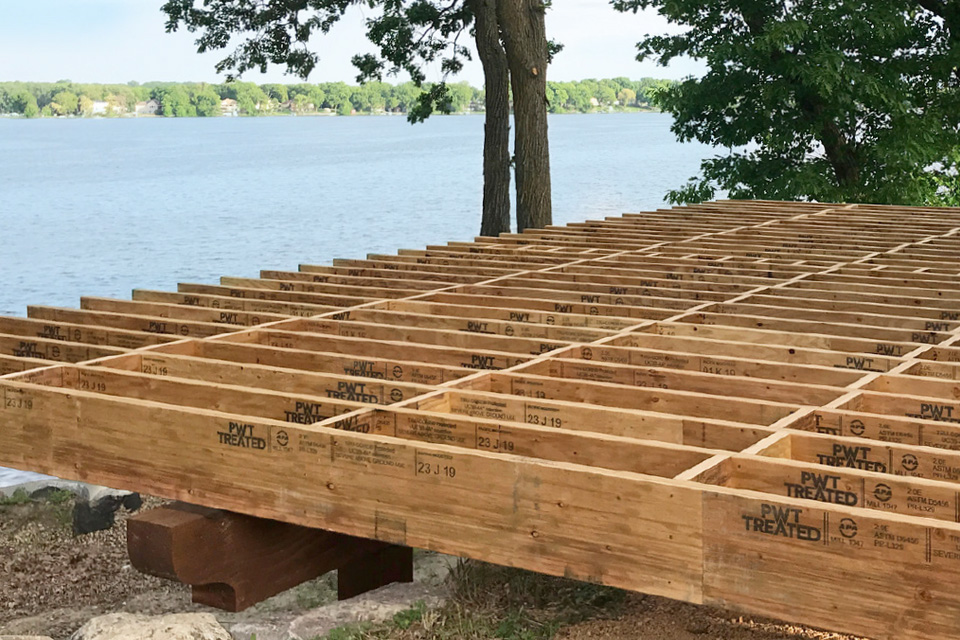
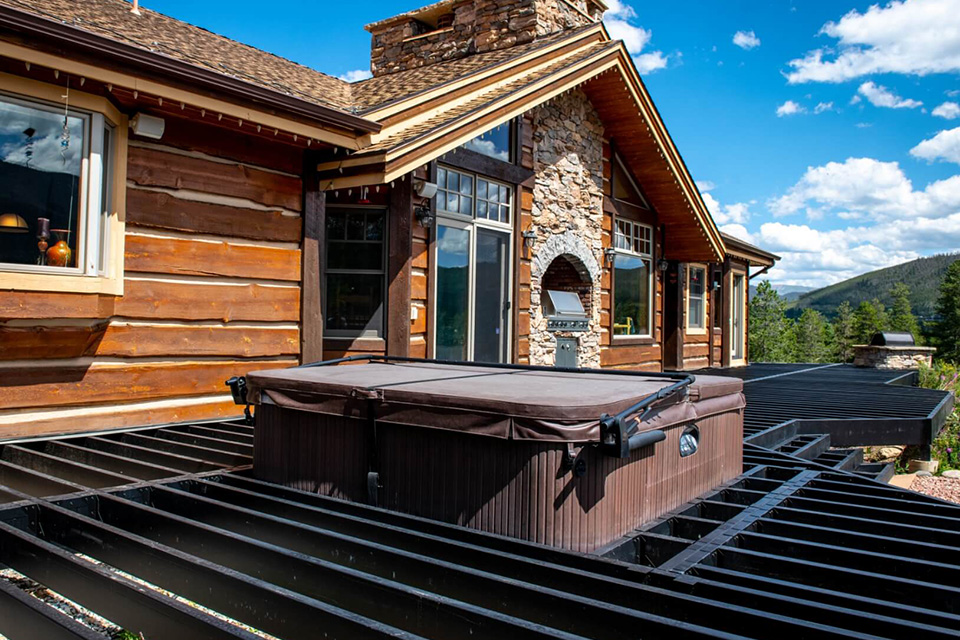
How to Choose the Right Deck Frame Material
Selecting the best material for your deck frame depends on several factors, including maintenance, budget, and aesthetic preferences.
How Much Maintenance Will Your Deck Frame Require?
If you want a deck that’s easier to maintain, pressure-treated wood is a reliable choice. It’s designed to resist moisture and insects, making it a low-maintenance option compared to untreated wood.
How Does Your Budget Affect Material Choice?
While Douglas fir has a lower initial cost, the long-term maintenance expenses can add up. Pressure-treated wood offers a balance between upfront cost and reduced maintenance, making it an affordable long-term solution.
What’s Your Preferred Deck Aesthetic?
Your personal taste plays a big role in material selection. If you love the natural look of wood grain, Douglas fir may be more appealing. However, if you prioritize durability and minimal maintenance, pressure-treated wood is likely a better fit.
Ready to Build Your Dream Deck?
At Pacific Northwest Decks, your trusted deck builder in Spokane, we specialize in custom decks tailored to your needs. Whether you’re considering pressure-treated wood or exploring other materials, we’re here to help. For a custom deck design, visit our Custom Deck Services page. Ready to get started? Contact us today for a phone consultation and start planning your perfect outdoor space!
FAQs about Pressure-Treated Wood Decks
1. What is pressure-treated wood and why is it used for deck frames?
Pressure-treated wood is chemically treated to resist rot, decay, and insects, making it ideal for deck frames in wet climates like Spokane, Washington.
2. Can I use non-pressure-treated wood for my deck?
While possible, it’s not recommended in areas with high moisture, as it can lead to rot and shorter deck life.
3. Is pressure-treated wood safe for residential decks?
Yes, modern pressure-treated wood uses safer preservatives that are EPA-approved for residential use.
4. How long does a pressure-treated deck typically last?
A well-installed pressure-treated deck can last up to 50 years, depending on quality, maintenance, and climate.
A well-installed pressure-treated deck can last up to 50 years, depending on quality, maintenance, and climate.

